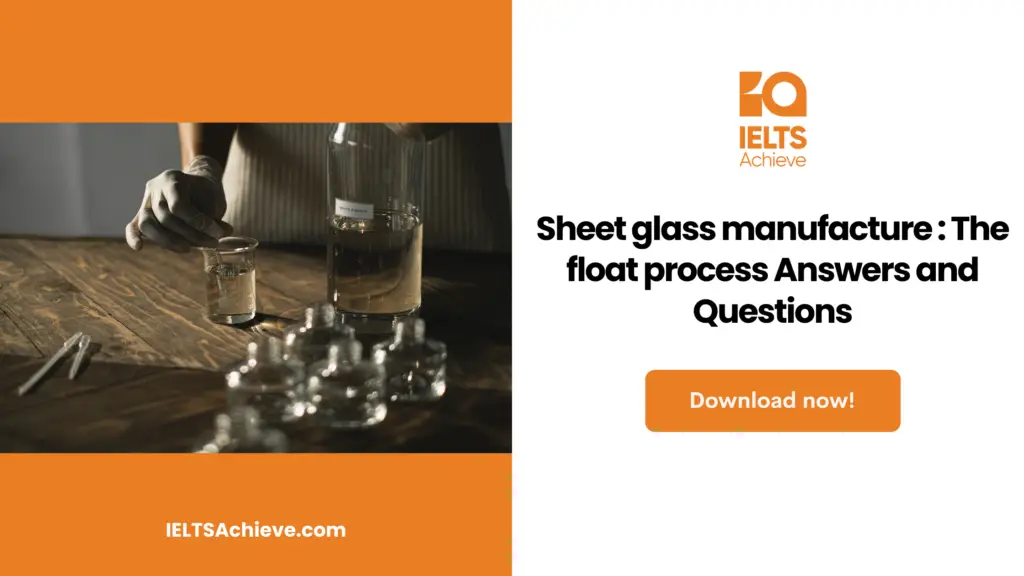The Blog post contains the following IELTS Reading Questions:
- IELTS reading table completion
- IELTS reading Diagram Labelling
- IELTS reading True/False/Not Given
Stay informed and prepared for success – Explore our comprehensive Reading Test Info page to get valuable insights, exam format details, and expert tips for mastering the IELTS Reading section.
IELTS Reading Passage : Sheet glass manufacture the float process

Sheet glass manufacture the float process
Glass, which has been assembled since the time of the Mesopotamians and Egyptians, is little more than a blend of sand, soda ash and lime. When heated to about 1500 degrees celsius (°C) this becomes a liquefied mass that freezes when slowly cooled. This first triumphant method for making clear, flat glass concerned with spinning. This method was very successful as the glass had not insane any surfaces between being soft and becoming tough, so it stayed excellently unblemished, with a ‘fire finish’. But, the process took a long period and was labor thorough. Nonetheless, there was a huge demand for the flat glass and glassmakers all over the world were looking for a process of making it constantly. The first uninterrupted ribbon making involved compressing liquefied glass through two hot rollers, alike to an old mangle. This permitted glass of effectively any width to be made ceaseless, however the rollers would leave both sides of the glass marked, and these would then need to be floor and shiny. This part of the making kneaded away around 20 percent of the glass, and the machines are very high-priced.
The float procedure for making flat glass was discovered by Alistair Pilkington. This procedure permit the produce of clear, tinted and covered glass for buildings, and clear and tinted glass for automobiles.pilkington had been testing with upgrading the melting process, and in 1952 he had the plan of using a bed of liquefied metal to form the flat glass, remove completely the need for rollers within the float bath. The metal had to melt at a less temperature than the solidify point of glass (about 600°C), but could not boil at a temperature below the temperature of the liquefied glass (about 1500°C). The best metal for the work was tin.The reminder concept depends on gravity, which swear that the surface of the liquified metal was excellently flat and horizontal. As a result, when streaming liquified glass onto the liquefied tin, the bottom of the glass would also be excellent flat. If the glass were kept very warm enough, it would flow over the liquified tin till the uppermost was also flat, horizontal and excellently aligned to the bottom surface. Once the glass chilled to 604°C or less it was challenging to mark and could be conveyed out of the freezing zone by rollers. The glass resolved to a width of 6 millimeters because of exterior tension interplay between the glass and the tin.
By coincidence, 60 percent of the flat glass market at the time was for 6 millimeter glass.Pilkington made a pilot plant in 1953 and by 1955 he had persuaded his company to build a full-scale plant. But, it took fourteen months of ceaseless manufacture, costing the company £100,000 a month, prior to the plant built any usable glass. Moreover, once they triumph in making marketable flat glass, the machine was opposed for a service to prepare it for years of continual manufacture. When it started up again it took one more 4 months to get the procedure right again. They eventually triumph in1959 and there are now floating plants across the world, with each able to make around 1000 tons of glass every day, ceaseless for around 15 years.Float plants today make glass of near optic standard. A few processes- melting, purifying, integration- take place at once in the 200 tonnes of liquified glass in the boiler. They happen in different zones in a compound glass flow driven by high weather. It adds up to a continual melting procedure, lasting as long as 50 hours, that delivers glass smoothly and continually to the float bath, and from there to a coating zone and eventually a heat treatment zone, where strain formed during freezing are glad.
The principle of float glass has remained unchanged since the 1950s. But, the product has changed badly, from a single width of 6.8mm to a range from sub-millimeter to 25mm, from a ribbon oftenly marred by incorporation and illusion to almost optic flawlessness. To secure high-quality,surveys take place at every stage. Sometimes, an illusion is not removed during purifying, a sand grain reject to melt, a trembling in the tin puts ripples into the glass ribbon. Robotic on-lline survey does two things. primarily , it divulges procedure faults that are ambitious that can be rectified. Survey automation permits more than 100 millions quantification a second to be made all over the ribbon, locating flaws the independently eye would be unable to see. Secondly, it enables computers to steer cutters around flaws. Float glass is vended by the square meter, and at the last stage computers translate consumer needs into motifs of cuts deliberately to reduce waste.
Unlock your full potential in the IELTS Reading section – Visit our IELTS Reading Practice Question Answer page now!
Recommended Questions:
Renewable Energy IELTS Reading Question with Answer
IELTS Reading Questions: Sheet glass manufacture the float process
Questions 1-8
- Complete the table and diagram below.
- Choose NO MORE THAN TWO WORDS from the passage for each answer.
- Write your answers in boxes 1-8 on your answer sheet.
Early methods of producing flat glass
| Method | Advantages | Disadvantages |
| 1 | • Glass remained 2 | • Slow • 3 |
| Ribbon | • Could produce glass sheets of varying 4 • Non-stop process | • Glass was 5 • 20% of glass rubbed away• Machines were expensive |
Boost your performance in Summary, Notes, Table, and Flowchart Completion tasks. Click here to explore our detailed guide and learn how to effectively complete summaries, notes, tables, and flowcharts in the IELTS Reading section.

6
7
8
Ready to tackle Diagram Label Completion tasks with confidence? Click here to access our comprehensive guide and learn how to accurately label parts or components of diagrams in the IELTS Reading section.
Questions 9-13
- Do the following statements agree with the information given in Reading Passage 1?
- In boxes 9-13 on your answer sheet, write
- TRUE if the statement agrees with the information
- FALSE if the statement contradicts the information
- NOT GIVEN if there is no information on this
9 The metal used in the float process had to have specific properties.
10 Pilkington invested some of his own money in his float plant.
11 Pilkington’s first full-scale plant was an instant commercial success.
12 The process invented by Pilkington has now been improved.
13 Computers are better than humans at detecting faults in glass.
Enhance your skills in identifying information as True, False, or Not Given. Click here to discover expert strategies and techniques for mastering this question type in the IELTS Reading section.
Unlock your full potential in the IELTS Reading section – Visit our IELTS Reading Practice Question Answer page now!
Recommended Questions:
Renewable Energy IELTS Reading Question with Answer
Sheet glass manufacture : The float process Reading Answers
1.spinning
2.(perfectly) unblemished
3.labour/labor-intensive
4.thickness
5.marked
6.(molten) glass
7.(molten) tin/metal
8.rollers
9.true
10.not given
11.false
12.true
13.true

We hope you found this post useful in helping you to study for the IELTS Test. If you have any questions please let us know in the comments below or on the Facebook page.
The best way to keep up to date with posts like this is to like us on Facebook, then follow us on Instagram and Pinterest. If you need help preparing for the IELTS Test, join the IELTS Achieve Academy and see how we can assist you to achieve your desired band score. We offer an essay correction service, mock exams and online courses.


